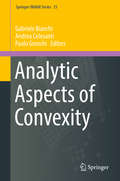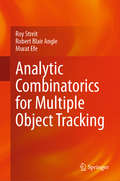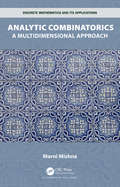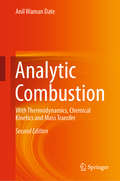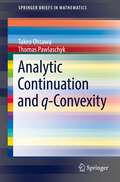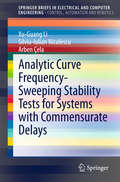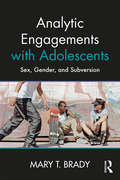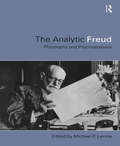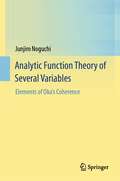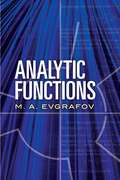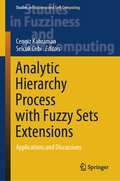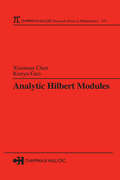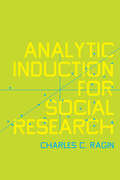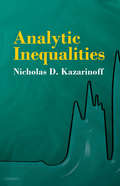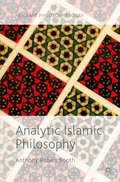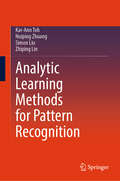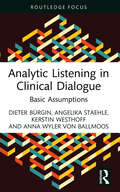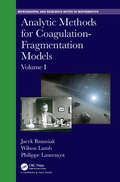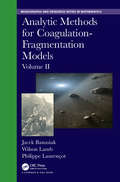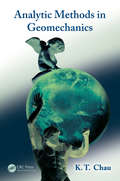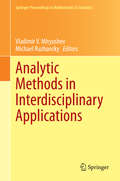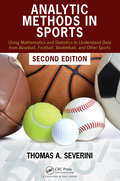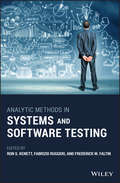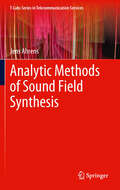- Table View
- List View
Analytic Aspects of Convexity (Springer INdAM #25)
by Gabriele Bianchi Andrea Colesanti Paolo GronchiThis book presents the proceedings of the international conference Analytic Aspects in Convexity, which was held in Rome in October 2016. It offers a collection of selected articles, written by some of the world’s leading experts in the field of Convex Geometry, on recent developments in this area: theory of valuations; geometric inequalities; affine geometry; and curvature measures. The book will be of interest to a broad readership, from those involved in Convex Geometry, to those focusing on Functional Analysis, Harmonic Analysis, Differential Geometry, or PDEs. The book is a addressed to PhD students and researchers, interested in Convex Geometry and its links to analysis.
Analytic Combinatorics
by Philippe Flajolet Robert SedgewickAnalytic Combinatorics is a self-contained treatment of the mathematics underlying the analysis of discrete structures, which has emerged over the past several decades as an essential tool in the understanding of properties of computer programs and scientific models with applications in physics, biology and chemistry. Thorough treatment of a large number of classical applications is an essential aspect of the presentation. Written by the leaders in the field of analytic combinatorics, this text is certain to become the definitive reference on the topic. The text is complemented with exercises, examples, appendices and notes to aid understanding therefore, it can be used as the basis for an advanced undergraduate or a graduate course on the subject, or for self-study.
Analytic Combinatorics for Multiple Object Tracking
by Roy Streit Robert Blair Angle Murat EfeThe book shows that the analytic combinatorics (AC) method encodes the combinatorial problems of multiple object tracking—without information loss—into the derivatives of a generating function (GF). The book lays out an easy-to-follow path from theory to practice and includes salient AC application examples. Since GFs are not widely utilized amongst the tracking community, the book takes the reader from the basics of the subject to applications of theory starting from the simplest problem of single object tracking, and advancing chapter by chapter to more challenging multi-object tracking problems. Many established tracking filters (e.g., Bayes-Markov, PDA, JPDA, IPDA, JIPDA, CPHD, PHD, multi-Bernoulli, MBM, LMBM, and MHT) are derived in this manner with simplicity, economy, and considerable clarity. The AC method gives significant and fresh insights into the modeling assumptions of these filters and, thereby, also shows the potential utility of various approximation methods that are well established techniques in applied mathematics and physics, but are new to tracking. These unexplored possibilities are reviewed in the final chapter of the book.
Analytic Combinatorics: A Multidimensional Approach (Discrete Mathematics and Its Applications)
by Marni MishnaAnalytic Combinatorics: A Multidimensional Approach is written in a reader-friendly fashion to better facilitate the understanding of the subject. Naturally, it is a firm introduction to the concept of analytic combinatorics and is a valuable tool to help readers better understand the structure and large-scale behavior of discrete objects. Primarily, the textbook is a gateway to the interactions between complex analysis and combinatorics. The study will lead readers through connections to number theory, algebraic geometry, probability and formal language theory. The textbook starts by discussing objects that can be enumerated using generating functions, such as tree classes and lattice walks. It also introduces multivariate generating functions including the topics of the kernel method, and diagonal constructions. The second part explains methods of counting these objects, which involves deep mathematics coming from outside combinatorics, such as complex analysis and geometry. Features Written with combinatorics-centric exposition to illustrate advanced analytic techniques Each chapter includes problems, exercises, and reviews of the material discussed in them Includes a comprehensive glossary, as well as lists of figures and symbols About the author Marni Mishna is a professor of mathematics at Simon Fraser University in British Columbia. Her research investigates interactions between discrete structures and many diverse areas such as representation theory, functional equation theory, and algebraic geometry. Her specialty is the development of analytic tools to study the large-scale behavior of discrete objects.
Analytic Combustion: With Thermodynamics, Chemical Kinetics and Mass Transfer
by Anil Waman DateThis book is intended to serve as a textbook for advanced undergraduate and graduate students as well as professionals engaged in application of thermo-fluid science to the study of combustion. The relevant thermo-chemistry and thermo-physical data required for this study are provided in the 6 appendices along with appropriate curve-fit coefficients. To facilitate gradual learning, two chapters are devoted to thermodynamics of pure and gaseous mixture substances, followed by one chapter each on chemical equilibrium and chemical kinetics. This material when coupled with a dedicated chapter on understanding of equations governing transport of momentum, heat and mass in the presence of chemical reactions provides adequate grounding to undertake analysis of practical combustion equipment, of premixed and diffusion flames as well as of solid particle and liquid droplet combustion. The learnings from the aforementioned chapters are taken to a uniquely strong chapter on application case studies, some of which have special relevance for developing countries.
Analytic Continuation and q-Convexity (SpringerBriefs in Mathematics)
by Takeo Ohsawa Thomas PawlaschykThe focus of this book is on the further development of the classical achievements in analysis of several complex variables, the analytic continuation and the analytic structure of sets, to settings in which the q-pseudoconvexity in the sense of Rothstein and the q-convexity in the sense of Grauert play a crucial role. After giving a brief survey of notions of generalized convexity and their most important results, the authors present recent statements on analytic continuation related to them. Rothstein (1955) first introduced q-pseudoconvexity using generalized Hartogs figures. Słodkowski (1986) defined q-pseudoconvex sets by means of the existence of exhaustion functions which are q-plurisubharmonic in the sense of Hunt and Murray (1978). Examples of q-pseudoconvex sets appear as complements of analytic sets. Here, the relation of the analytic structure of graphs of continuous surfaces whose complements are q-pseudoconvex is investigated. As an outcome, the authors generalize results by Hartogs (1909), Shcherbina (1993), and Chirka (2001) on the existence of foliations of pseudoconcave continuous real hypersurfaces by smooth complex ones. A similar generalization is obtained by a completely different approach using L²-methods in the setting of q-convex spaces. The notion of q-convexity was developed by Rothstein (1955) and Grauert (1959) and extended to q-convex spaces by Andreotti and Grauert (1962). Andreotti–Grauert's finiteness theorem was applied by Andreotti and Norguet (1966–1971) to extend Grauert's solution of the Levi problem to q-convex spaces. A consequence is that the sets of (q-1)-cycles of q-convex domains with smooth boundaries in projective algebraic manifolds, which are equipped with complex structures as open subsets of Chow varieties, are in fact holomorphically convex. Complements of analytic curves are studied, and the relation of q-convexity and cycle spaces is explained. Finally, results for q-convex domains in projective spaces are shown and the q-convexity in analytic families is investigated.
Analytic Curve Frequency-Sweeping Stability Tests for Systems with Commensurate Delays (SpringerBriefs in Electrical and Computer Engineering)
by Silviu-Iulian Niculescu Xu-Guang Li Arben ÇelaIn this brief the authors establish a new frequency-sweeping framework to solve the complete stability problem for time-delay systems with commensurate delays. The text describes an analytic curve perspective which allows a deeper understanding of spectral properties focusing on the asymptotic behavior of the characteristic roots located on the imaginary axis as well as on properties invariant with respect to the delay parameters. This asymptotic behavior is shown to be related by another novel concept, the dual Puiseux series which helps make frequency-sweeping curves useful in the study of general time-delay systems. The comparison of Puiseux and dual Puiseux series leads to three important results: an explicit function of the number of unstable roots simplifying analysis and design of time-delay systems so that to some degree they may be dealt with as finite-dimensional systems; categorization of all time-delay systems into three types according to their ultimate stability properties; and a simple frequency-sweeping criterion allowing asymptotic behavior analysis of critical imaginary roots for all positive critical delays by observation. Academic researchers and graduate students interested in time-delay systems and practitioners working in a variety of fields - engineering, economics and the life sciences involving transfer of materials, energy or information which are inherently non-instantaneous, will find the results presented here useful in tackling some of the complicated problems posed by delays.
Analytic Engagements with Adolescents: Sex, Gender, and Subversion
by Mary T. BradyIn Analytic Engagements with Adolescents, Mary T. Brady takes on the intensity and 'heat' of adolescent psychoanalytic treatment.She is a guide in the distinctive challenges of work with adolescents. The intensity of this work manifests in various ways; the heightened importance of body issues and related transference and countertransference, the subversiveness of risk-taking behavior and the rejection and rebellion against authority, and the effects of parental response and family dynamics. Adolescence is a period when 'things happen': first wet dreams, first menstruation, first romance. Nascent sexuality comes directly into the field as the adolescent is confronted with new bodily experiences. Subversiveness is integral to the adolescent’s development; parents (and analysts) are overthrown as the adolescent questions the status quo and experiments with new capacities and desires. Drawn into the adolescent’s turbulence, Bion’s concept of 'thinking under fire' is shown to be vital to the analyst’s engagement. Bion’s group theory here informs Brady’s immediate experience of the interaction of individual and family dynamics. The voices of Brady’s adolescent patients and her dynamic involvement with them will help the clinician to be open to the 'hot' moments of their analytic work. Drawing on Bion’s thinking and her own extensive experience with adolescents, Brady offers an essential guide to the difficulties and challenges encountered when working with this patient group. She provides practical suggestions for psychoanalysts and psychoanalytic psychotherapists working in this area.
Analytic Freud: Philosophy and Psychoanalysis
by Michael P. LevineThis is a timely and stimulating collection of essays on the importance of Freudian thought for analytic philosophy, investigating its impact on mind, ethics, sexuality, religion and epistemology.Marking a clear departure from the long-standing debate over whether Freudian thought is scientific or not, The Analytic Freud expands the framework of philosophical inquiry, demonstrating how fertile and mutually enriching the relationship between philosophy and psychoanalysis can be.The essays are divided into four clear sections, addressing the implications of Freud for philosophy of mind, ethics, sexuality and civilisation. The authors discuss the problems psychoanalysis poses for contemporary philosophy as well as what philosophy can learn from Freud's legacy and undeniable influence. For instance, The Analytic Freud discusses the problems presented by pyschoanalytic theories of the mind for the philosophy of language; the issues which current theories of mind and meaning raise for psychoanalytic accounts of emotion, metaphor, the will and self-deception; the question whether psychoanalytic theory is essential in understanding sexuality, love, humour and the tensions which arise out of personal relationships.The Analytic Freud is a critical and thorough examination of Freudian and post-Freudian theory, adding a welcome and significant dimension to the debate between psychoanalysis and contemporary philosophy.
Analytic Function Theory of Several Variables: Elements of Oka’s Coherence
by Junjiro NoguchiThe purpose of this book is to present the classical analytic function theory of several variables as a standard subject in a course of mathematics after learning the elementary materials (sets, general topology, algebra, one complex variable). This includes the essential parts of Grauert–Remmert's two volumes, GL227(236) (Theory of Stein spaces) and GL265 (Coherent analytic sheaves) with a lowering of the level for novice graduate students (here, Grauert's direct image theorem is limited to the case of finite maps).The core of the theory is "Oka's Coherence", found and proved by Kiyoshi Oka. It is indispensable, not only in the study of complex analysis and complex geometry, but also in a large area of modern mathematics. In this book, just after an introductory chapter on holomorphic functions (Chap. 1), we prove Oka's First Coherence Theorem for holomorphic functions in Chap. 2. This defines a unique character of the book compared with other books on this subject, in which the notion of coherence appears much later.The present book, consisting of nine chapters, gives complete treatments of the following items: Coherence of sheaves of holomorphic functions (Chap. 2); Oka–Cartan's Fundamental Theorem (Chap. 4); Coherence of ideal sheaves of complex analytic subsets (Chap. 6); Coherence of the normalization sheaves of complex spaces (Chap. 6); Grauert's Finiteness Theorem (Chaps. 7, 8); Oka's Theorem for Riemann domains (Chap. 8). The theories of sheaf cohomology and domains of holomorphy are also presented (Chaps. 3, 5). Chapter 6 deals with the theory of complex analytic subsets. Chapter 8 is devoted to the applications of formerly obtained results, proving Cartan–Serre's Theorem and Kodaira's Embedding Theorem. In Chap. 9, we discuss the historical development of "Coherence".It is difficult to find a book at this level that treats all of the above subjects in a completely self-contained manner. In the present volume, a number of classical proofs are improved and simplified, so that the contents are easily accessible for beginning graduate students.
Analytic Functions (Dover Books on Mathematics)
by M.A. EvgrafovThis highly regarded text is directed toward advanced undergraduates and graduate students in mathematics who are interested in developing a firm foundation in the theory of functions of a complex variable. The treatment departs from traditional presentations in its early development of a rigorous discussion of the theory of multiple-valued analytic functions on the basis of analytic continuation. Thus it offers an early introduction of Riemann surfaces, conformal mapping, and the applications of residue theory. M. A. Evgrafov focuses on aspects of the theory that relate to modern research and assumes an acquaintance with the basics of mathematical analysis derived from a year of advanced calculus.Starting with an introductory chapter containing the fundamental results concerning limits, continuity, and integrals, the book addresses analytic functions and their properties, multiple-valued analytic functions, singular points and expansion in series, the Laplace transform, harmonic and subharmonic functions, extremal problems and distribution of values, and other subjects. Chapters are largely self-contained, making this volume equally suitable for the classroom or independent study.
Analytic Hierarchy Process with Fuzzy Sets Extensions: Applications and Discussions (Studies in Fuzziness and Soft Computing #428)
by Cengiz Kahraman Selcuk CebiThis book presents a comprehensive guide to Analytic Hierarchy Process with Fuzzy Sets Extensions. Written by prominent researchers, it offers readers a step-by-step approach to decision-making that can be applied to a wide range of real-world problems. With clear explanations and practical examples, this book is an essential resource for researchers, lecturers, and postgraduate students pursuing research on Analytic Hierarchy Process with Fuzzy Sets Extensions. Each chapter in the book provides a wealth of both basic and advanced concepts, including Interval Type-2 Fuzzy AHP, Intuitionistic Fuzzy AHP, Hesitant Fuzzy AHP, Pythagorean Fuzzy AHP, Picture Fuzzy AHP, q-Rung Orthopair Fuzzy AHP, Spherical Fuzzy AHP, Circular Intuitionistic Fuzzy AHP, and Decomposed Fuzzy AHP. To foster a better understanding, all the chapters include relevant numerical examples or case studies, making it easy to apply the concepts in practice. Moreover, the book extends all the main aspects of Analytic Hierarchy Process with Fuzzy Sets Extensions, presenting a dynamic snapshot of the field that is expected to stimulate new directions, ideas, and developments. In summary, this book is an essential reference guide for anyone seeking to gain a deep understanding of Analytic Hierarchy Process with Fuzzy Sets Extensions. It is written in a rigorous and scholarly manner, making it a valuable resource for researchers and academics. Order your copy today and discover the practical insights and strategies for decision-making offered by this authoritative volume.
Analytic Hilbert Modules (Chapman And Hall/crc Research Notes In Mathematics Ser. #433)
by Kunyu Guo Xiaoman ChenThe seminal 1989 work of Douglas and Paulsen on the theory of analytic Hilbert modules precipitated a number of major research efforts. This in turn led to some intriguing and valuable results, particularly in the areas of operator theory and functional analysis. With the field now beginning to blossom, the time has come to collect those results un
Analytic Induction for Social Research
by Charles C. RaginA free ebook version of this title is available through Luminos, University of California Press’s Open Access publishing program. Visit www.luminosoa.org to learn more. This book explores analytic induction, an approach to the analysis of cross-case evidence on qualitative outcomes that has deep roots in sociology. A popular research technique in the early decades of empirical sociology, analytic induction differs fundamentally as a method of social research from conventional variation-based approaches. In Analytic Induction for Social Research, Charles C. Ragin demonstrates that much is gained from systematizing analytic induction. The approach he introduces here offers a new template for conducting cross-case analysis and provides a new set of tools for answering common research questions that existing methods cannot address.
Analytic Inequalities
by Nicholas D. KazarinoffMathematical analysis is largely a systematic study and exploration of inequalities -- but for students the study of inequalities often remains a foreign country, difficult of access. This book is a passport to that country, offering a background on inequalities that will prepare undergraduates (and even high school students) to cope with the concepts of continuity, derivative, and integral.Beginning with explanations of the algebra of inequalities and conditional inequalities, the text introduces a pair of ancient theorems and their applications. Explorations of inequalities and calculus cover the number e, examples from the calculus, and approximations by polynomials. The final sections present modern theorems, including Bernstein's proof of the Weierstrass approximation theorem and the Cauchy, Bunyakovskii, Hölder, and Minkowski inequalities. Numerous figures, problems, and examples appear throughout the book, offering students an excellent foundation for further studies of calculus.
Analytic Islamic Philosophy (Palgrave Philosophy Today)
by Anthony Robert BoothThis book is an introduction to Islamic Philosophy, beginning with its Medieval inception, right through to its more contemporary incarnations. Using the language and conceptual apparatus of contemporary Anglo-American ‘Analytic’ philosophy, this book represents a novel and creative attempt to rejuvenate Islamic Philosophy for a modern audience. It adopts a ‘rational reconstructive’ approach to the history of philosophy by affording maximum hermeneutical priority to the strongest possible interpretation of a philosopher’s arguments while also paying attention to the historical context in which they worked. The central canonical figures of Medieval Islamic Philosophy – al-Kindi, al-Farabi, Avicenna, al-Ghazali, Averroes – are presented chronologically along with an introduction to the central themes of Islamic theology and the Greek philosophical tradition they inherited. The book then briefly introduces what the author collectively refers to as the ‘Pre-Modern’ figures including Suhrawardi, Mulla Sadra, and Ibn Taymiyyah, and presents all of these thinkers, along with their Medieval predecessors, as forerunners to the more modern incarnation of Islamic Philosophy: Political Islam.
Analytic Learning Methods for Pattern Recognition
by Kar-Ann Toh Huiping Zhuang Simon Liu Zhiping LinThis textbook is a consolidation of learning methods which comes in an analytic form. The covered learning methods include classical and advanced solutions to problems of regression, minimum classification error, maximum receiver operating characteristics, bridge regression, ensemble learning and network learning. Both the primal and dual solution forms are discussed for over-and under-determined systems. Such coverage provides an important perspective for handling systems with overwhelming samples or systems with overwhelming parameters. For goal driven classification, the solutions to minimum classification-error, maximum receiver operating characteristics, bridge regression, and ensemble learning represent recent advancements in the literature. In this book, the exercises offer instructors and students practical experience with real-world applications.
Analytic Listening in Clinical Dialogue: Basic Assumptions (Routledge Focus on Mental Health)
by Dieter Bürgin Angelika Staehle Kerstin Westhoff Anna Wyler von BallmoosAnalytic Listening in Clinical Dialogue focuses on the work of four leading clinicians as they assess how their unconscious basic assumptions impact their clinical work. Using the case study of a seven-year-old boy, the authors evaluate a videotaped psychoanalytic first interview and exchange their mutual clinical approaches. Their discussions uncover the way that unconscious basic assumptions arise from the core of one’s personality and act as the pillars that support primary- and secondary-process thinking. These fundamental models of thought and emotion result in convictions which play a key role in the processes of understanding, evaluating, classifying, anticipating and regulating. The authors show how an ‘analytic listening’ approach can also be used to good effect in supervisions and intervisions, as it provides a path out of the domain of ‘being right’ into a space of what is shared as well as what is different. They argue that this method allows an analyst’s own blind spots to be reduced. Translated from the original German, Analytic Listening in Clinical Dialogue will be of great interest to psychoanalysts, psychotherapists and psychologists.
Analytic Methods for Coagulation-Fragmentation Models, Volume I (Chapman & Hall/CRC Monographs and Research Notes in Mathematics)
by Jacek Banasiak Wilson Lamb Philippe LaurencotAnalytic Methods for Coagulation-Fragmentation Models is a two-volume set that provides a comprehensive exposition of the mathematical analysis of coagulation-fragmentation models. Initially, an in-depth survey of coagulation-fragmentation processes is presented, together with an account of relevant early results obtained on the associated model equations. These provide motivation for the subsequent detailed treatment of more up-to-date investigations which have led to significant theoretical developments on topics such as solvability and the long-term behaviour of solutions. To make the account as self-contained as possible, the mathematical tools that feature prominently in these modern treatments are introduced at appropriate places. The main theme of Volume I is the analysis of linear fragmentation models, with Volume II devoted to processes that involve the nonlinear contribution of coagulation. Features of Volume I: The main models of the theory together with their derivations and early methods of solution A detailed presentation of the operator theoretical methods and semigroup theory that play an essential role in the theory of fragmentation processes A comprehensive theory of fragmentation processes, including fragmentation with growth and decay in both the discrete and continuous particle size cases An analytical explanation of the `pathologies’ of the fragmentation equation, such as the shattering phase transition and non-uniqueness of solutions An analysis of the long-term dynamics of the discrete size fragmentation equation with growth
Analytic Methods for Coagulation-Fragmentation Models, Volume II (Chapman & Hall/CRC Monographs and Research Notes in Mathematics)
by Jacek Banasiak Wilson Lamb Philippe LaurencotAnalytic Methods for Coagulation-Fragmentation Models is a two-volume set that provides a comprehensive exposition of the mathematical analysis of coagulation-fragmentation models. Initially, an in-depth survey of coagulation-fragmentation processes is presented, together with an account of relevant early results obtained on the associated model equations. These provide motivation for the subsequent detailed treatment of more up-to-date investigations which have led to significant theoretical developments on topics such as solvability and the long-term behaviour of solutions. To make the account as self-contained as possible, the mathematical tools that feature prominently in these modern treatments are introduced at appropriate places. The main theme of Volume I is the analysis of linear fragmentation models, with Volume II devoted to processes that involve the nonlinear contribution of coagulation. Features of Volume II: A primer on weak compactness in L 1 and dynamical systems A comprehensive theory of solvability of the coagulation-fragmentation equation by both the semigroup and weak compactness methods, including a thorough analysis of the gelation and shattering phenomena A detailed analysis of the long-term dynamics of the coagulation-fragmentation equations with a state-of-the-art discussion on self-similar solutions
Analytic Methods in Geomechanics
by Kam-tim ChauA multidisciplinary field, encompassing both geophysics and civil engineering, geomechanics deals with the deformation and failure process in geomaterials such as soil and rock. Although powerful numerical tools have been developed, analytical solutions still play an important role in solving practical problems in this area. Analytic Methods in Geomechanics provides a much-needed text on mathematical theory in geomechanics, beneficial for readers of varied backgrounds entering this field.Written for scientists and engineers who have had some exposure to engineering mathematics and strength of materials, the text covers major topics in tensor analysis, 2-D elasticity, and 3-D elasticity, plasticity, fracture mechanics, and viscoelasticity. It also discusses the use of displacement functions in poroelasticity, the basics of wave propagations, and dynamics that are relevant to the modeling of geomaterials. The book presents both the fundamentals and more advanced content for understanding the latest research results and applying them to practical problems in geomechanics.The author gives concise explanations of each subject area, using a step-by-step process with many worked examples. He strikes a balance between breadth of material and depth of details, and includes recommended reading in each chapter for readers who would like additional technical information. This text is suitable for students at both undergraduate and graduate levels, as well as for professionals and researchers.
Analytic Methods in Interdisciplinary Applications (Springer Proceedings in Mathematics & Statistics #116)
by Michael Ruzhansky Vladimir V. MityushevThe book includes lectures given by the plenary and key speakers at the 9th International ISAAC Congress held 2013 in Krakow, Poland. The contributions treat recent developments in analysis and surrounding areas, concerning topics from the theory of partial differential equations, function spaces, scattering, probability theory, and others, as well as applications to biomathematics, queueing models, fractured porous media and geomechanics.
Analytic Methods in Sports: Using Mathematics and Statistics to Understand Data from Baseball, Football, Basketball, and Other Sports
by Thomas A. SeveriniOne of the greatest changes in the sports world in the past 20 years has been the use of mathematical methods to analyze performances, recognize trends and patterns, and predict results. Analytic Methods in Sports: Using Mathematics and Statistics to Understand Data from Baseball, Football, Basketball, and Other Sports, Second Edition provides a concise yet thorough introduction to the analytic and statistical methods that are useful in studying sports. The book gives you all the tools necessary to answer key questions in sports analysis. It explains how to apply the methods to sports data and interpret the results, demonstrating that the analysis of sports data is often different from standard statistical analyses. The book integrates a large number of motivating sports examples throughout and offers guidance on computation and suggestions for further reading in each chapter. Features Covers numerous statistical procedures for analyzing data based on sports results Presents fundamental methods for describing and summarizing data Describes aspects of probability theory and basic statistical concepts that are necessary to understand and deal with the randomness inherent in sports data Explains the statistical reasoning underlying the methods Illustrates the methods using real data drawn from a wide variety of sports Offers many of the datasets on the author’s website, enabling you to replicate the analyses or conduct related analyses New to the Second Edition R code included for all calculations A new chapter discussing several more advanced methods, such as binary response models, random effects, multilevel models, spline methods, and principal components analysis, and more Exercises added to the end of each chapter, to enable use for courses and self-study Full solutions manual available to course instructors.
Analytic Methods in Systems and Software Testing
by Fabrizio Ruggeri Ron S. Kenett Frederick W. FaltinA comprehensive treatment of systems and software testing using state of the art methods and tools This book provides valuable insights into state of the art software testing methods and explains, with examples, the statistical and analytic methods used in this field. Numerous examples are used to provide understanding in applying these methods to real-world problems. Leading authorities in applied statistics, computer science, and software engineering present state-of-the-art methods addressing challenges faced by practitioners and researchers involved in system and software testing. Methods include: machine learning, Bayesian methods, graphical models, experimental design, generalized regression, and reliability modeling. Analytic Methods in Systems and Software Testing presents its comprehensive collection of methods in four parts: Part I: Testing Concepts and Methods; Part II: Statistical Models; Part III: Testing Infrastructures; and Part IV: Testing Applications. It seeks to maintain a focus on analytic methods, while at the same time offering a contextual landscape of modern engineering, in order to introduce related statistical and probabilistic models used in this domain. This makes the book an incredibly useful tool, offering interesting insights on challenges in the field for researchers and practitioners alike. Compiles cutting-edge methods and examples of analytical approaches to systems and software testing from leading authorities in applied statistics, computer science, and software engineering Combines methods and examples focused on the analytic aspects of systems and software testing Covers logistic regression, machine learning, Bayesian methods, graphical models, experimental design, generalized regression, and reliability models Written by leading researchers and practitioners in the field, from diverse backgrounds including research, business, government, and consulting Stimulates research at the theoretical and practical level Analytic Methods in Systems and Software Testing is an excellent advanced reference directed toward industrial and academic readers whose work in systems and software development approaches or surpasses existing frontiers of testing and validation procedures. It will also be valuable to post-graduate students in computer science and mathematics.
Analytic Methods of Sound Field Synthesis (T-Labs Series in Telecommunication Services)
by Jens AhrensThis book puts the focus on serving human listeners in the sound field synthesis although the approach can be also exploited in other applications such as underwater acoustics or ultrasonics. The author derives a fundamental formulation based on standard integral equations and the single-layer potential approach is identified as a useful tool in order to derive a general solution. He also proposes extensions to the single-layer potential approach which allow for a derivation of explicit solutions for circular, planar, and linear distributions of secondary sources. Based on above described formulation it is shown that the two established analytical approaches of Wave Field Synthesis and Near-field Compensated Higher Order Ambisonics constitute specific solutions to the general problem which are covered by the single-layer potential solution and its extensions.
